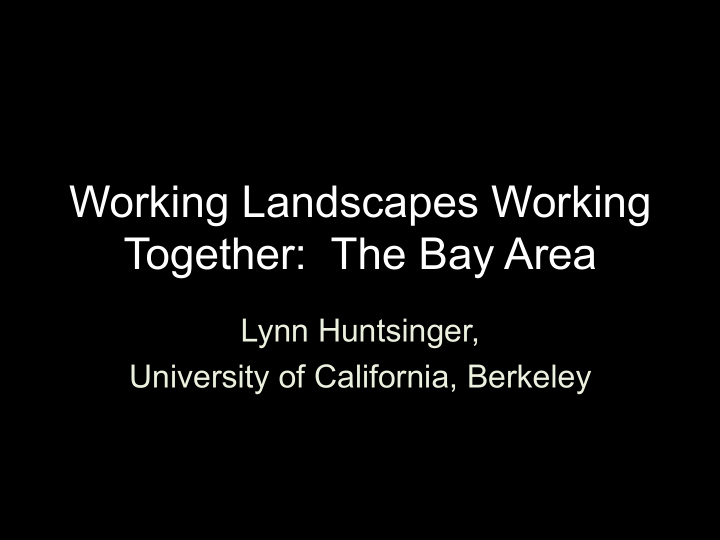



Working Landscapes Working Together: The Bay Area Lynn Huntsinger, University of California, Berkeley
Synergies!
Working Landscapes Multiple benefits: ecosystem services including food, habitat, viewshed, heritage.
Pasture Scale: Producing the ecosystem service of wildlife habitat Species may benefit from grazing to alter grassland structure • shorter grass, openings. • species or structural heterogeneity • tool to manage invasives • Western burrowing owl (CCWD 2005). • Stephens kangaroo rats (Kelt et al 2005; USFWS 1997) • Goldfields (Barry 2005) • Some insects/beetles (Dennis et al 1997) • Western pond turtle (CCWD 2005). • Butterflies (Weiss, 1999)
Vernal Pools • Grazing benefits documented by Pyke and Marty, Marty 2005.
Conservation of working landscapes requires all three: • Pasture: manage grazing to achieve environmental effects. • Ranch: sustainable enterprise. • Landscape: year round forage supply from mix of private, leased, and public land.
Interdependence and feedback Landscape Ranch Pasture
Ranchers as “ecosystem engineers” • Create habitats, local and landscape effects (Jones et al 1997). • Ranchers and ranching can be “ecosystem services”
Pasture scale: construction and maintenance of stockponds
Landscape level ecosystem engineering: Network of stockponds across a working landscape benefits tiger salamanders and livestock. (Science Applications International, Corp.)
The concept of ecosystem services implies that people are not active participants in the production of benefits to society from ecosystem management. Perhaps we should talk about “social ecological services” SES Environmental services created by the interaction of people and the environment
Recent paper on ecosystem services as social ecological services at http://www.ecologyandsociety.org/ vol19/iss1/art8/
"Tiger salamanders are the most lucrative livestock I've ever raised."
Ranchers benefit from ecosystem services from their land and enterprise 90% + in California, Colorado, say that living near “natural beauty” is an important motive for ranching (Huntsinger ¡et ¡al. ¡2010; ¡ Rowe ¡et ¡al.) ¡ ¡
Synergies: mutual benefits from ranch stewardship Rancher ecosystem Public ecosystem services benefits • Natural beauty • Natural beauty • Existence and • Living on property viewshed • Wildlife and recreation • Wildlife and recreation • Legacy value: heirs • Legacy value: future generations • Production value • Local ranch products
The End --Sustainable ranches need a stable, year round, forage supply --Cows are not plants: pastoralism world-wide makes use of mobility
A typical East Bay ranch (Sulak 2007) 19% Owned by participant Leased from private landowner 50% Leased from public agency 31% --Median date of establishment: 1890 --Competition for public leases is fierce as the forage base shrinks. --Used 4 private leases on average, one used 15 private and public
"They think we can put the cows on a shelf when they don't need them."
If I lost my public leases … • Would suffer a significant decline in income (41%). • Would have to reduce herd size. • Would like to buy or lease more land but it is increasingly difficult to find. • 35% - 50% might sell the ranch. • Public agencies select the ranches that survive?? (Sulak 2007)
Landscape Scale: Feedbacks of development or exclusion Ranch Limits management Costs to farm and Developed or Loss of forage base Pressure to sell Ranch land Loss of infrastructure increase taken out of Loss of community production feedback loop: loss of ranches increases loss of ranches (Sulak and Huntsinger 2007)
77% of CA ranchers think that ranching can survive
“It’s not open space.”
Bay ¡Area ¡Foodscapes ¡ Bay ¡Nature ¡Magazine ¡
Conclusions: the landscape we know and ranching are interdependent • Managed and stewarded by ranchers, and part of the ranching economy. • Ranching can provide ecosystem stewardship and services on private as well as public lands. • Ranchers need an affordable, year-round forage supply that fits the livestock calendar. • Agencies, mitigation management have important impacts on regional private land conservation
• Ecosystem services from the pasture depend on maintaining the ranch and the landscape. • Can’t maintain landscape level services without the pasture and the ranch.
Recommend
More recommend